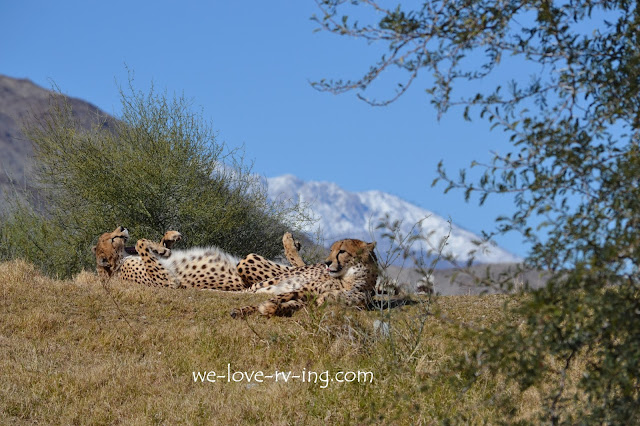The Living Desert Museum was opened in 1970 in Palm Desert,
CA of the Coachella Valley and has since evolved into the Living Desert Zoo and
Gardens. The desert environment which
includes botanical gardens and over 450 wild animals of Africa and North America
are on the 1200 protected acres. There
are many dedicated employees and even more volunteers always willing to share information about their Living Desert.
 |
| A Giraffe welcome |
A big draw to the Living Desert are the giraffes. There are several giraffe in this family
which includes a young one who was the first in line for his food while we were
there. Their long purple tongue will grow
to 18”. The most amazing fact I learned
was that they only sleep about half an hour a day!
 |
| Feeding the Giraffe |
Our visit was timed to be there during the feeding of the
giraffes. This is done twice daily plus
a ‘giraffe chat’ in the afternoon following the afternoon feeding. A contribution of $5.00 will give you carrots
to feed the giraffes yourself. They are
very gentle but don’t like to be touched so you pop the carrot onto their
tongue.
 |
| "are you looking at me?" |
They only have 7 vertebrae in their neck, the same as humans
which sounds amazing when you consider how long that neck is! The giraffe is the tallest four legged animal
and grows to 19’ weighing 1.5 tons. They
walk with such grace and almost appear to be moving in slow motion in their
pacing walk but can run up to 35 mph.
 |
| The giraffe family at Living Desert |
The male and female stand differently when they eat, which
allows one to know which sex they are when seen from a great distance. She arches her neck and body to eat lower shrubs
and trees and he reaches to the tree tops of the acacia trees, their favorite. They are able to get most of the water they
need as well as almost all nutrition from the acacia tree leaves.
 |
| the Greater Kudu |
The Greater Kudu are compatible with the giraffe so are
sharing the same acreage with them. This
incredible male has beautiful spiral horns that differentiate him from the
female. They all have 6-10 thin pale
stripes on their sides and are considered the most attractive of the different
breeds of antelope family, of which they are from. The male can weigh 256 kilograms (565 lbs)
but will jump heights over 2.5 metres (8.25 feet) when startled.
 |
| Naptime for many |
Everyone knows the zebra but there are several animals that
are not familiar to many of us. Many I
was not able to photograph as they were behind caged areas but some of those I
was able to see properly included the African bat-eared fox, (top left) who is no relation
to other foxes and the fennec fox, (top right) the smallest of the fox family at 3.5 pounds. The Curvier’s gazelles (bottom center) who are extremely rare in their homeland, are part of breeding
programs. The large bird is the
Abyssinian ground hornbills which has a wingspan of 6 feet. This is one of only two hornbills out of 53 varieties
that are ground dwellers.
 |
| Living Desert Camel |
Camels are considered the Noble Beast of Burden. The most common is the one-humped camel
called a dromedary camel. They are found
in North Africa, the Sahara Desert and the Middle East and have been domesticated
for centuries. Their hump consists of
fat, which allows them to go a long time without food and although they are
able to drink up to 30 gallons at a time, they can also survive for 10 months
without water. That would never happen
here but it may have been necessary in their early days in the Sahara Desert
and the like.
 |
| Such a handsome camel face |
The camel has a very interesting face. Their longer eyelashes and bushy eyebrows
protect them against sandstorms, as well as they have sealing nostrils and fur
lined ears to do that job, as well. They
have a lifespan of about 45 years.
 |
| "wanna play?" |
The camel was the transportation for many in centuries past
and can still be considered a good ride today.
There are camel rides available at the Living Desert now, too. These two camels were in a corral waiting for
their turn at giving rides, I think, and seem to be playfully chomping on each
other out of boredom!
 |
| Miniature train display |
I cannot show photos of the Living Desert without including
some of the mini train display. This is
amazing and has many working trains to watch cross trestles over canyons and
rivers. The volunteers who have been
involved in building this over the years have done an amazing job. Be sure to stop by and check this out should
you be visiting the Living Desert.
I couldn’t possibly cover all the animals, birds,
butterflies, reptiles……… and everything else in the Living Desert on this
page. I have more photos to share of my
favorite visit of this day, though. The
cheetahs were magnificent so watch for that to be on here soon.
If you wish to learn more about the Living
Desert, click
here and see what else they have in this incredible place.






















































